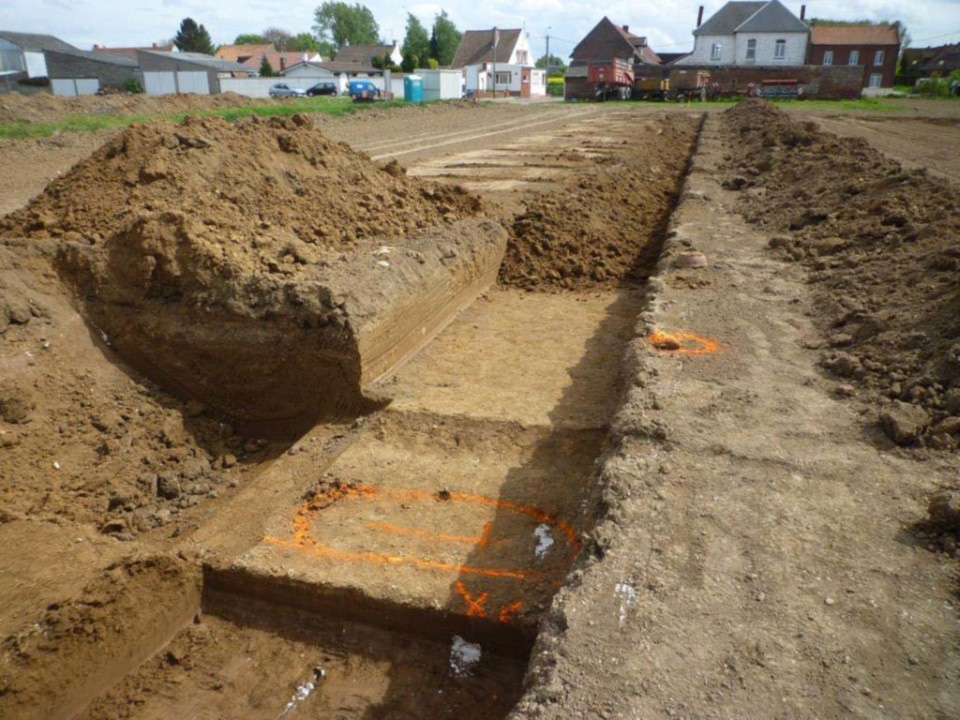Sergeant James Alexander Milne
In 2013, remains of Sergeant James Alexander Milne were found in Arleux-en-Gohelle, France. He was killed and reported missing after the assault on Arleux-en-Gohelle, on April 28, 1917.
- Born 10 February 1883 in Gellybrands, Cookney, Kincardinshire, Scotland
- Died 28 April 1917 at the age of 34
- Died a member of the 10th Canadian Infantry Battalion (Canadians), CEF
- Remains discovered 5 May 2013 in Arleux-en-Gohelle, France
- Buried at Commonwealth War Graves Commission’s Orchard Dump Cemetery, Section 6, Plot K, Grave 5
James Alexander Milne was born on 10 February 1883, at Gellybrands, Cookney, Kincardineshire, Scotland. Raised by his maternal grandmother Eliza Valentine (née Smith, widowed Milne), he immigrated to Canada between 1905 and 1911. He was unmarried and worked as a labourer in Calgary before enlisting in the Canadian Expeditionary Force (CEF) on 27 January 1915 with the 50th Canadian Infantry Battalion (Calgary), CEF.
At enlistment, he declared on his attestation papers that his birthplace was Stonehaven and his birth year 1886. It is impossible to know why he provided this information although Stonehaven was five miles southeast of Cookney and was the larger settlement.
The 50th Battalion departed Camp Valcartier for England on 27 October 1915 arriving at Bramshott Military Camp on 6 November 1915. On 3 February 1916 Private Milne and many others of the 50th Battalion transferred to the 9th Reserve Infantry Battalion CEF, for further training. On 15 March 1916, he transferred to the 10th Canadian Infantry Battalion (Canadians), CEF, a battalion of the 1st Canadian Division, 2nd Canadian Infantry Brigade in the Canadian Corps serving in France and Belgium.
Taken on strength of the 10th Battalion on 19 March 1916, he was with the battalion when it returned to the trenches not far from Ypres. He was present for the German assault at Mount Sorrel on 2 June 1916 where the 10th Battalion helped in preventing the Germans from breaking through the line.
Appointed Lance Corporal on 12 June following Mount Sorrel he then survived the heavy fighting on the Somme from August to October 1916. Milne likely exhibited leadership abilities since he was promoted to Corporal on 14 February 1917 on the same day the battalion was inspected by Field Marshal Haig.
He then participated in the attack on Vimy Ridge on 9 April 1917 and that same day promoted to the rank of Sergeant while in the field. His promotion was made substantive 24 April 1917.
He then participated in the assault on Arleux-en-Gohelle, 28 April 1917 where he was killed and reported missing.
Following the war, Sergeant Milne's name was engraved on the Canadian National Vimy Memorial commemorating canadian soldiers who died during the First World War and have no known grave.
On 5 May 2013, just over 96 years after the death of Sergeant Milne, an archaeology team uncovered human remains while conducting mandatory excavation for the building of a new housing estate in Arleux-en-Gohelle, France.
Artefacts recovered with the remains suggested they were of a Canadian soldier from the 10th Infantry Battalion during the First World War. There were numerous identifying buttons, buckles as well as a pair of boots and a corroded identification disc.
The Canadian Conservation Institute treated and cleaned the identification disc to reveal the inscriptions. On the bottom of the disc “10 BN” was clearly legible. The numbers “434”, followed by a corroded blank space of about one character, followed by “56” indicated a service number. In the upper right of the disc were the letters “LNE”. The only service number of those missing that started with “434” and ended with “56” was that of Sergeant James Alexander Milne. He was also the only one of the missing with the letter combination “LNE” in his name.
Through historical, genealogical, anthropological and archaeological analysis, with the assistance of the Canadian Forces Forensic Odontology Response Team, the Canadian Museum of History and, the Canadian Conservation Institute, the Casualty Identification Review Board was able to confirm the identity of the remains as Sergeant James Alexander Milne in December 2016.
Sergeant Milne was buried on 25 August 2017 in Commonwealth War Gaves Commission's Orchard Dump Cemetery in Arleux-en-Gohelle, France by members of The Calgary Highlanders from Calgary, Alberta. Attending the burial were representatives of the Government of Canada, the local French government and the Canadian Armed Forces. Photographs of the ceremony can be viewed on the Canadian Army’s flickr page.
For further information on Sergeant Milne, you can view his personnel file on the Library and Archives Canada website.
Information about casualty identification
Page details
- Date modified:






